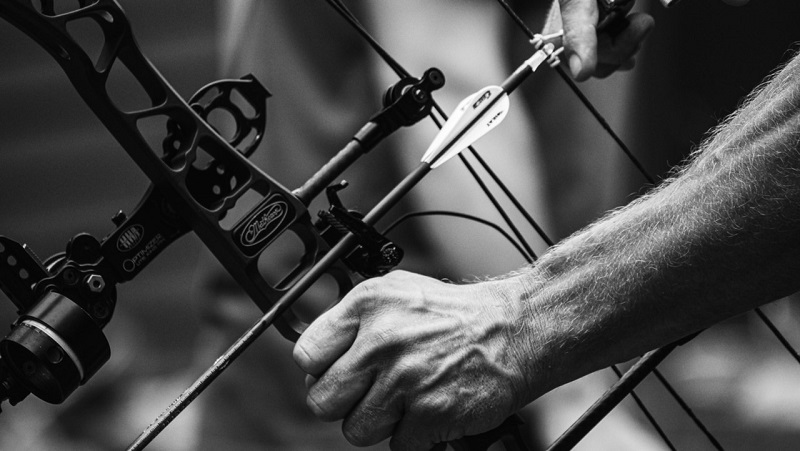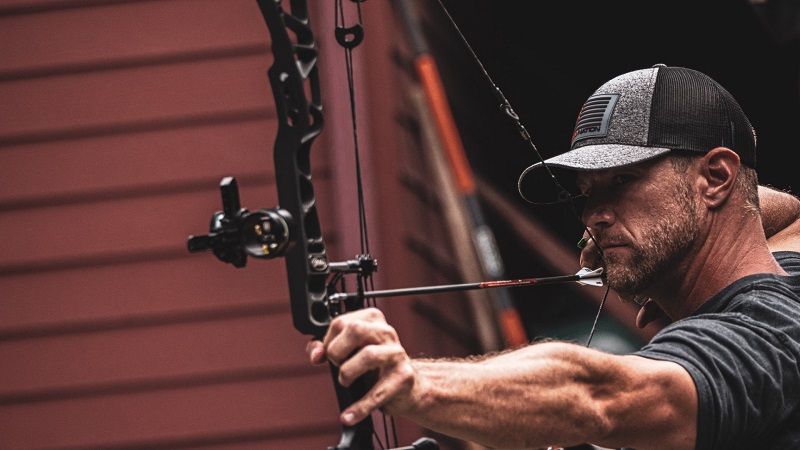It was opening day of Maryland’s bow season, and I was twelve hours from home in an area I had never set foot in. As I scouted my way into a good-looking creek bottom, I realized it was bone dry due to the recent drought. I followed the creek bed and eventually came upon a deeper portion still holding a small puddle of water. Surrounding the water were hundreds of fresh tracks and a couple of large buck tracks. Realizing I had found a gold mine, I set up my tree saddle 17’ up a nearby walnut tree about 25 yards downwind of the water hole.

Target Panic and Shot Execution in Bowhunting
About two hours before dark, I watched a six-point buck approach the water hole without a care in the world. Observing his excitement to hit the water, I knew I was in for a special sit.
Over the next hour, I watched more than a dozen does, fawns, and small bucks drink from this water hole. With about 30 minutes of daylight left, I caught movement heading down the creek bed. As the large set of dark antlers lumbered my way, I knew without a doubt that it was a mature whitetail.
My heart began to race as I quietly grabbed my bow. My only thought was,
“Don’t mess this up!”
Making his way down the creek bed, the buck had finally came to a stop. There he was, standing perfectly broadside, presenting me a beautiful twenty-nine-yard shot. I drew my bow, found my anchor, and was attempting to settle my pin when — whoosh!
My heart dropped. I had slapped the trigger, effectively sending my arrow six inches over the buck’s back. With my adrenaline flowing, I could hardly even recall everything that had just happened. Years later I would learn exactly what was going on: I was suffering from the worst case of target panic known to man. At that time, it was nothing new. In fact, in a two year stretch I had missed multiple big whitetails and even wounded a couple of them. Even to this day, that was the darkest stretch I have ever experienced as a bow hunter. After missing that whitetail, I vowed that I was going to diagnose the problem and fix it.
So What Was The Problem?
After digging in and doing some research, I found out that there were literally thousands of bow hunters just like me that were suffering from target panic. Getting a shot at a mature buck is no easy task, but I’m surprised every year just how many of the hunters in my large circle of friends/acquaintances actually get that opportunity. That said, a decent percentage of those guys still come home without a buck in the truck. I’m told stories each year of the big buck they missed or wounded and never recovered. The actual shot on the animal is often the most under-emphasized part of the entire hunting process. Everyone is so concerned with gear, tactics, and where to set up that they often don’t put the appropriate amount of time and energy into mastering their weapon and, more importantly, their shot process.
I believe there are far too many hunters that don’t have true control of their shot process. I know because I was one of them.
What is Target Panic?
A lot of guys believe the reason they miss is due to a phenomenon referred to as “buck fever.” While the surge of adrenaline when a shot is materializing (known as buck fever) can certainly impact your fine motor control and overall accuracy, I think most guys miss due to some level of target panic accompanied by a poor shot execution process.
To put it simply, target panic is the inability to execute a smooth shot process due to the anticipation of the shot which causes your entire shot process to break down.

Signs of Target Panic
Target panic can manifest itself in several different ways. One common sign is when your pin freezes under the target. This results in you jerking your bow arm up into the vitals or bullseye while simultaneously punching the trigger.
Other signs include rushing the shot when you don’t intend to or bracing yourself right before the bow fires. High-pressure situations such as shooting in front of your friends, an archery competition, or that big buck standing broadside at 25 yards usually exacerbate the issue. Target panic may come from being overly concerned about the outcome of the shot and trying to control the exact timing of the shot instead of focusing on form and execution.
Other Signs/Symptoms:
- Drive-by Shooting: holding off target and then bringing your pin up, across, or down to the target area and then punching your release as it crosses over it.
- Constantly saying to yourself: “I’m not sure what happened, I rushed the shot.”
- Inability to place your pin on the spot you want to hit (holding low).
- You don’t actually have a specific shot process that you work through.
If you are experiencing some sort of target panic, the next question to ask yourself is,
“How do I fix it?”
The answer depends on who you ask. In my opinion, there are several great teachers out there that all have slightly different methodology and opinions on how to remedy target panic while getting your shot process under control. If you look closely, you’ll notice the common goal among them all is to develop the ability to master an unanticipated release. Developing an unanticipated release means you are able to run a smooth shot process while allowing your pin to float on the target without panic, anticipation, or any other involuntary movements before the bow fires.
Now, more than ever, it’s easy to find archery experts offering to develop a controlled shot process.
A Few Thoughts and Ideas That Helped Me
- Pin movement is completely normal and acceptable. No archer holds the pin perfectly still. You have to accept your pin float and it should have no impact at all on your execution process or shot timing.
- It simply doesn’t matter what your pin is doing (within reason of course) and as long as you focus on the spot you want to hit your pin will constantly keep re-centering itself to that spot. As long as you can run a smooth shot execution while allowing your pin to constantly re-center itself, you will hit the mark or very close to it.

Drills That Helped Cure My Target Panic
Aim Without Shooting
Draw your bow back and splash your pin immediately on the spot you want to hit. Allow it to float there with your finger on the trigger with no intention of firing the shot. When your aiming breaks down, let your bow down, rest, and repeat. This teaches your brain that it’s ok to have your pin on the bullseye without hitting the trigger.
Shoot Without Aiming
For this drill, position yourself about 10 ft or less from the target. You can remove your sight as you won’t be aiming with this drill. Draw the bow back, come to anchor, talk through your shot execution, and fire the arrow into the target at close range. You are trying to engrain your new physical and mental shot process. It’s important to have a shot process that you work through systematically and it can help immensely if you talk your way through the process.
Once I get to full draw I use these words to work through my process: “Anchor,” (I find my anchor point), “Settle,” (I splash the pin on the spot and let it settle), “Aim,” (I simply let the pin float and never think about aiming again), “PULL, PULL, PULL,” (I start the physical action of pulling through the release using a back tension execution method until the shot fires). This shot execution routine helps me work through each step of the process. Once you engrain the process (1,500 shots or more recommended), you can put your sight back on your bow and add a dot to the target. Slowly start working your way back over the coming weeks staying disciplined with the new process.
The Drawn-Out Execution
I got this drill from John Dudley about a decade ago, and it really helped solidify my process and bring everything together. Basically, you draw the bow, find your anchor, aim, and once you begin your “pull,” you try to do it as slowly as possible. Try to imagine pulling so slow that it takes 10 seconds or more for your bow to fire. This long, slow pull really trains you to stay committed to your shot process and to be disciplined within that critical last phase known as “the pull.” During this drill, your brain may switch over from thinking about “pull” to “why is this taking so long and why hasn’t my bow fired?” Be disciplined and keep your mind on the “pull” part of the process until the bow fires.
This is a high-level drill and is used by some elite-level archers to help train their brains to stay focused on the shot while not allowing other thoughts to cloud their shot execution. I worked on these specific drills for about three months in the off-season before I started shooting at 3d targets again. I found my target panic was gone. My brain was completely re-wired, and I had developed an entirely new shot process. A process that was easily repeatable and stood up to the stress of high pressure situations.
Do Release Types Matter?
One may get varying opinions on this but I do believe release types matter. To be more specific, release characteristics matter. There are many releases out there that simply cause anticipation issues that could potentially lead to full blown target panic. My recommendation is to avoid releases that have these characteristics:
Light Trigger
Releases with a hair trigger can cause the shooter to be afraid to preload the trigger. These types of releases almost force you to punch the trigger to get it to fire, because you can’t pre-load the trigger in order to perform a well-executed shot.
Trigger With Travel
Excessive travel in a trigger allows your brain to quickly learn when your release is going to fire. If your brain knows this, it can anticipate it and cause your body to tense up before the shot is fired.
Nonadjustable Trigger
I want a release that has tension adjustment and travel adjustment. I want to be able to set the trigger heavier if needed and the ability to adjust all of the travel out of the trigger. Additionally, for an index finger release, I want one that has the length adjustable so I can set it back further in my palm so I can wrap my index finger around it like a hook. This reduces the risk of punching and sets up well for more of a pull through shot execution.
Here are a few links to some great releases with good adjustable triggers that break clean like a fine rifle trigger and adjust for travel and tension.
You might be asking yourself: “Why is another target panic article popping up this time of year?” Well, it’s because now is the perfect time to address the issue of target panic. Now is the perfect time to put in the required work in order to finally get your shot process under control.
Good luck out there, and shoot straight!
Comment or ask Andy questions here.


















